Freezing and Thawing of D2O/Sand Mixtures Investigated by Neutron Diffraction
Abstract
:1. Introduction
2. Materials and Methods
3. Results and Discussion
3.1. Analysis of D2O Ice Texture Changes during the Repeated Freezing and Thawing of Samples
3.2. Texture Changes within Single Freezing/Thawing Cycle
3.3. Split of Diffraction Maxima and Internal Stress Load
4. Conclusions
Author Contributions
Funding
Institutional Review Board Statement
Informed Consent Statement
Data Availability Statement
Conflicts of Interest
References
- Saruya, T.; Nakajima, K.; Takata, M.; Homma, T.; Azuma, N.; Goto-Azuma, K. Effects of microparticles on deformation and microstructural evolution of fine-grained ice. J. Glaciol. 2019, 65, 531–541. [Google Scholar] [CrossRef] [Green Version]
- Montagnat, M.; Löwe, H.; Calonne, N.; Schneebeli, M.; Matzl, M.; Jaggi, M. On the Birth of Structural and Crystallographic Fabric Signals in Polar Snow: A Case Study from the EastGRIP Snowpack. Front. Earth Sci. 2020, 8, 365. [Google Scholar] [CrossRef]
- Das, S.; Castaneda, P.P. A multiphase homogenization model for the viscoplastic response of intact sea ice: The effect of porosity and crystallographic texture. Int. J. Multiscale Comp. Eng. 2019, 17, 121–150. [Google Scholar] [CrossRef]
- Montagnat, M.; Bourcier, M.; Philip, A.; Bons, P.D.; Bauer, C.C.; Deconinck, P.; Hereil, P. Texture characterization of some large hailstones with an automated technique. J. Glaciol. 2021, 1–15. [Google Scholar] [CrossRef]
- Litwin, K.L.; Zygielbaum, B.R.; Polito, P.J.; Sklar, L.S.; Collins, G.C. Influence of temperature, composition, and grain size on the tensile failure of water ice: Implications for erosion on Titan. J. Geophys. Res. 2012, 117, E08013. [Google Scholar] [CrossRef]
- Deville, S.; Viazzi, C.; Leloup, J.; Lasalle, A.; Guizard, C.; Maire, E.; Adrien, J.; Gremillard, L. Ice Shaping Properties, Similar to That of Antifreeze Proteins, of a Zirconium Acetate Complex. PLoS ONE 2011, 6, e26474. [Google Scholar] [CrossRef] [PubMed] [Green Version]
- Hu, F.; Li, Z.; Tian, Y.; Hu, R. Failure Patterns and Morphological Soil–Rock Interface: Characteristics of Frozen Soil–Rock Mixtures under Compression and Tension. Appl. Sci. 2021, 11, 461. [Google Scholar] [CrossRef]
- Cook, K.L.K.; Hartel, R.W. Mechanisms of Ice Crystallization in Ice Cream Production. CRFSFS 2010, 9, 213–222. [Google Scholar] [CrossRef]
- Bronfenbrener, L. The modelling of the freezing process in fine-grained porous media: Application to the frost heave estimation. Cold Reg. Sci. Technol. 2009, 56, 120–134. [Google Scholar] [CrossRef]
- Style, R.W.; Peppin, S.S.L. The kinetics of ice-lens growth in porous media. J. Fluid Mech. 2012, 692, 482–498. [Google Scholar] [CrossRef] [Green Version]
- Chen, P.; Luo, H.; Liu, E. Moisture transfer and formation of separate ice in the freezing process of saturated soils. Water 2020, 12, 1044. [Google Scholar] [CrossRef] [Green Version]
- Deville, S.; Adrien, J.; Maire, E.; Scheel, M.; Di Michiel, M. Time-lapse, three-dimensional in situ imaging of ice crystal growth in a colloidal silica suspension. Acta Mater. 2013, 61, 2077–2086. [Google Scholar] [CrossRef] [Green Version]
- Monz, M.E.; Hudleston, P.J.; Prior, D.J.; Michels, Z.; Fan, S.; Negrini, M.; Langhorne, P.J.; Qi, C. Full crystallographic orientation (c and a axes) of warm, coarse-grained ice in a shear-dominated setting: A case study, Storglaciären, Sweden. Cryosphere 2021, 15, 303–324. [Google Scholar] [CrossRef]
- Tseng, Y.-H.; Cheng, C.-C.; Cheng, H.-P.; Lee, D. Novel Real-Time Diagnosis of the Freezing Process Using an Ultrasonic Transducer. Sensors 2015, 15, 10332–10349. [Google Scholar] [CrossRef] [PubMed] [Green Version]
- Tamtögl, A.; Bahn, E.; Sacchi, M.; Zhu, J.; Ward, D.J.; Jardine, A.P.; Jenkins, S.J.; Fouquet, P.; Ellis, J.; Allison, W. Motion of water monomers reveals a kinetic barrier to ice nucleation on graphene. Nat. Commun. 2021, 12, 3120. [Google Scholar] [CrossRef]
- Fortes, A.D. Accurate and precise lattice parameters of H2O and D2O ice Ih between 1.6 and 270 K from high resolution time-of-flight neutron powder diffraction data. Acta Cryst. 2018, B74, 196–216. [Google Scholar] [CrossRef]
- Wilson, C.J.L.; Hunter, N.J.R.; Luzin, V.; Peternell, M.; Piazollo, S. The influence of strain rate and presence of dispersed second phases on the deformation behavior of polycrystalline D2O ice. J. Glaciol. 2019, 65, 101–122. [Google Scholar] [CrossRef] [Green Version]
- Kalvoda, L.; Kichanov, S.E.; Kucerakova, M.; Lukin, E.V.; Vratislav, S. Ice Melting Kinetics in Sand-Water Mixtures Investigated by Neutron Radiography and Diffraction. J. Cold Reg. Eng. 2019, 33, 04019003. [Google Scholar] [CrossRef]
- Searf, V.F. Neutron scattering lengths and cross sections. Neutron News 1992, 3, 29–37. [Google Scholar]
- Petkov, V.; Bakaltchev, N. FIT, a computer program for decomposition of powder diffraction patterns and profile analysis of pair correlation functions. J. Appl. Crystallogr. 1990, 23, 138–140. [Google Scholar] [CrossRef] [Green Version]
- Toby, B.H.; Von Dreele, R.B. GSAS-II: The genesis of a modern open-source all-purpose crystallography software package. J. Appl. Crystallogr. 2013, 46, 544–549. [Google Scholar] [CrossRef]
- Harris, G.B. Quantitative measurement of preferred orientation in rolled uranium bars. Philos. Mag. 1952, 43, 113–123. [Google Scholar] [CrossRef]
- Neumeier, J.J. Elastic Constants, Bulk Modulus, and Compressibility of H2O Ice Ih for the Temperature Range 50 K–273 K. J. Phys. Chem. Ref. Data 2018, 47, 033101. [Google Scholar] [CrossRef] [Green Version]
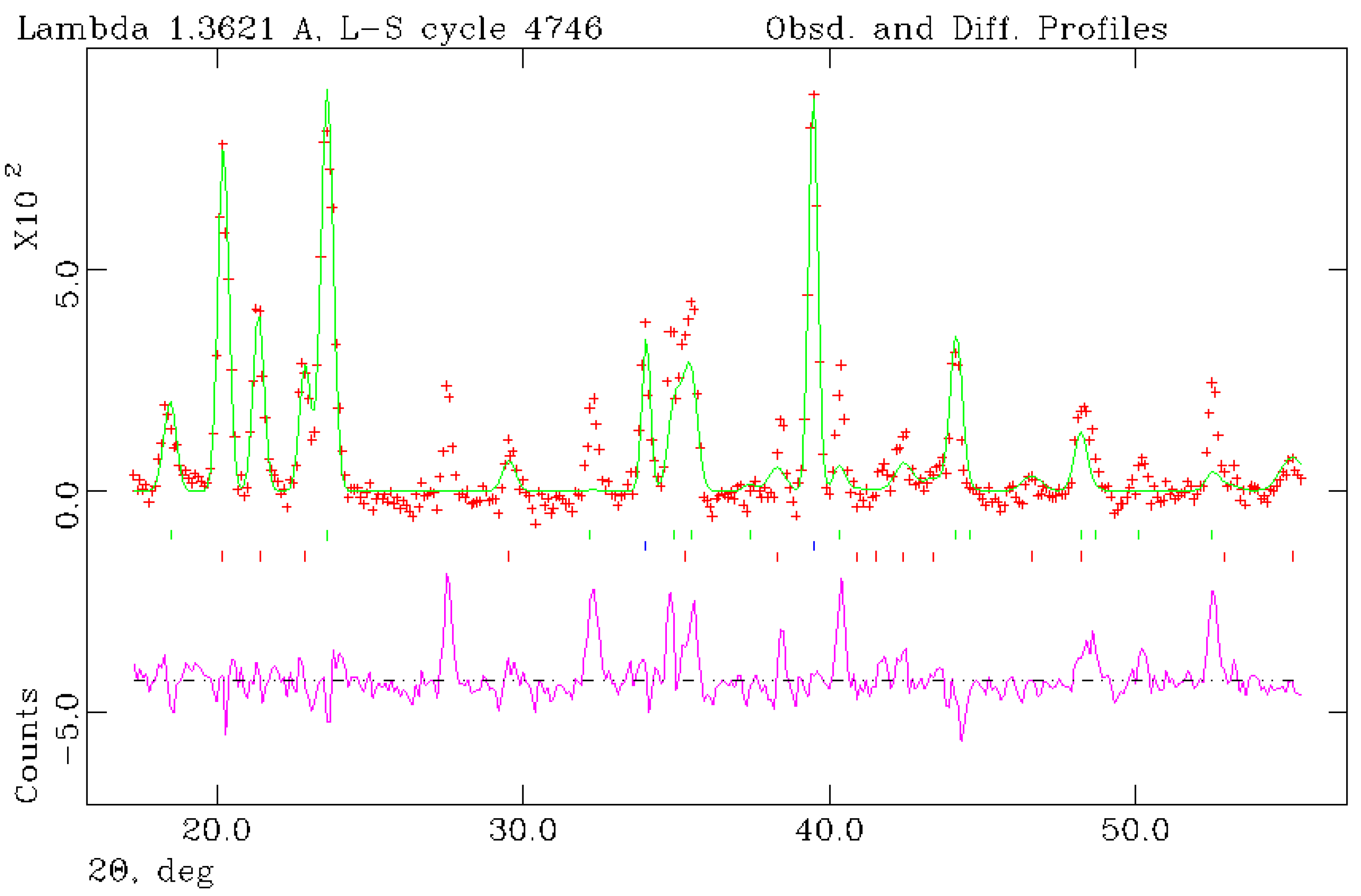
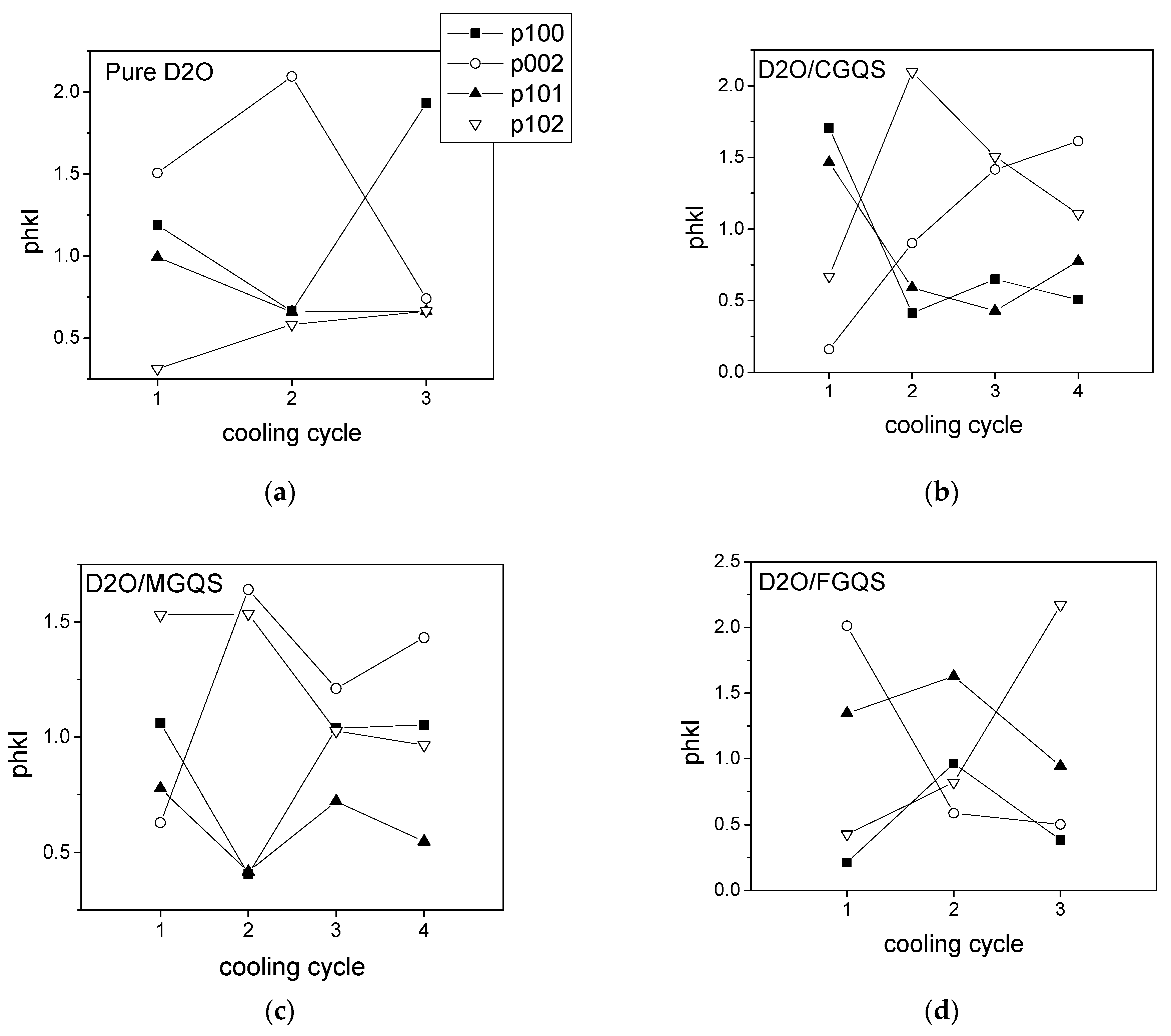
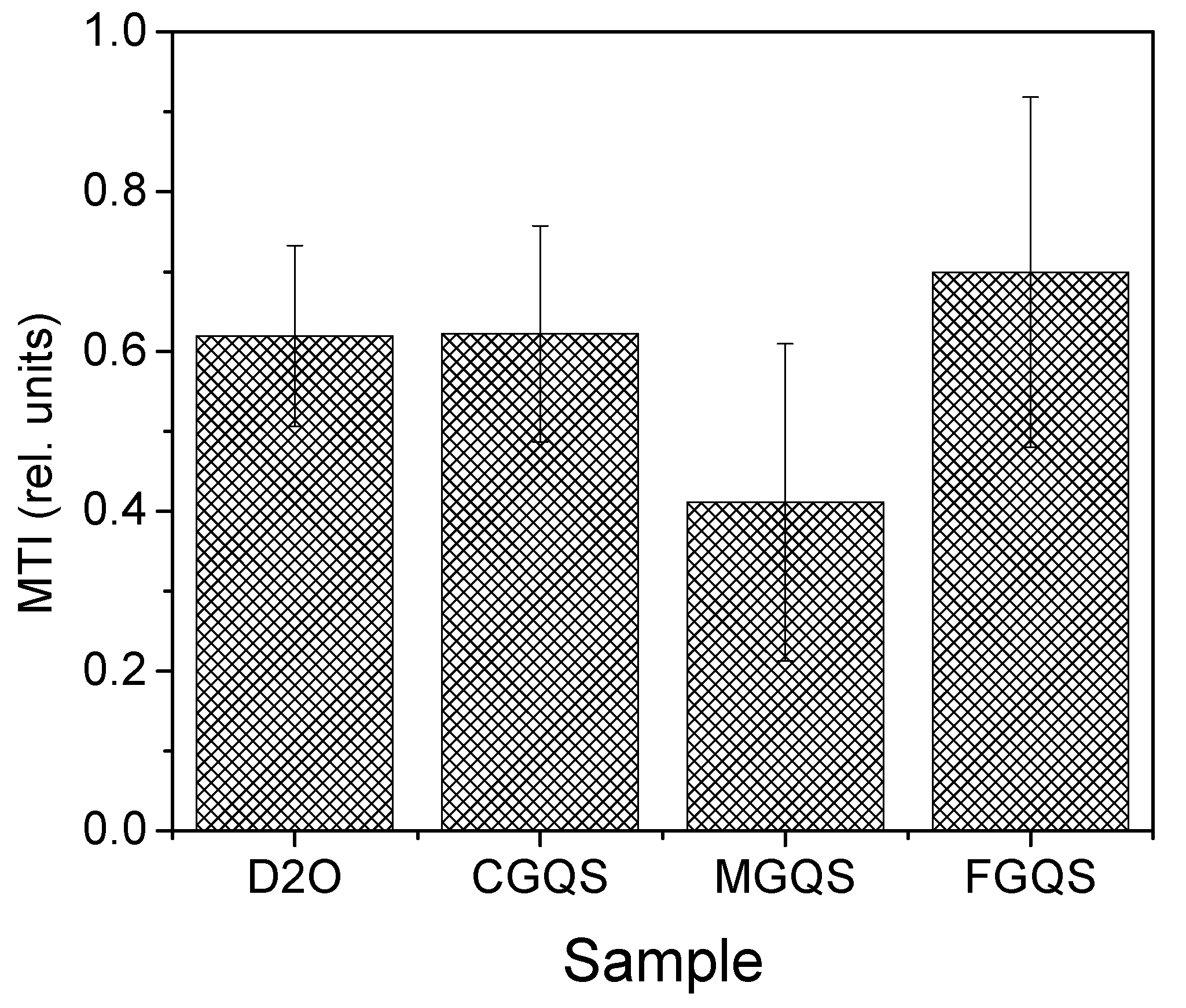

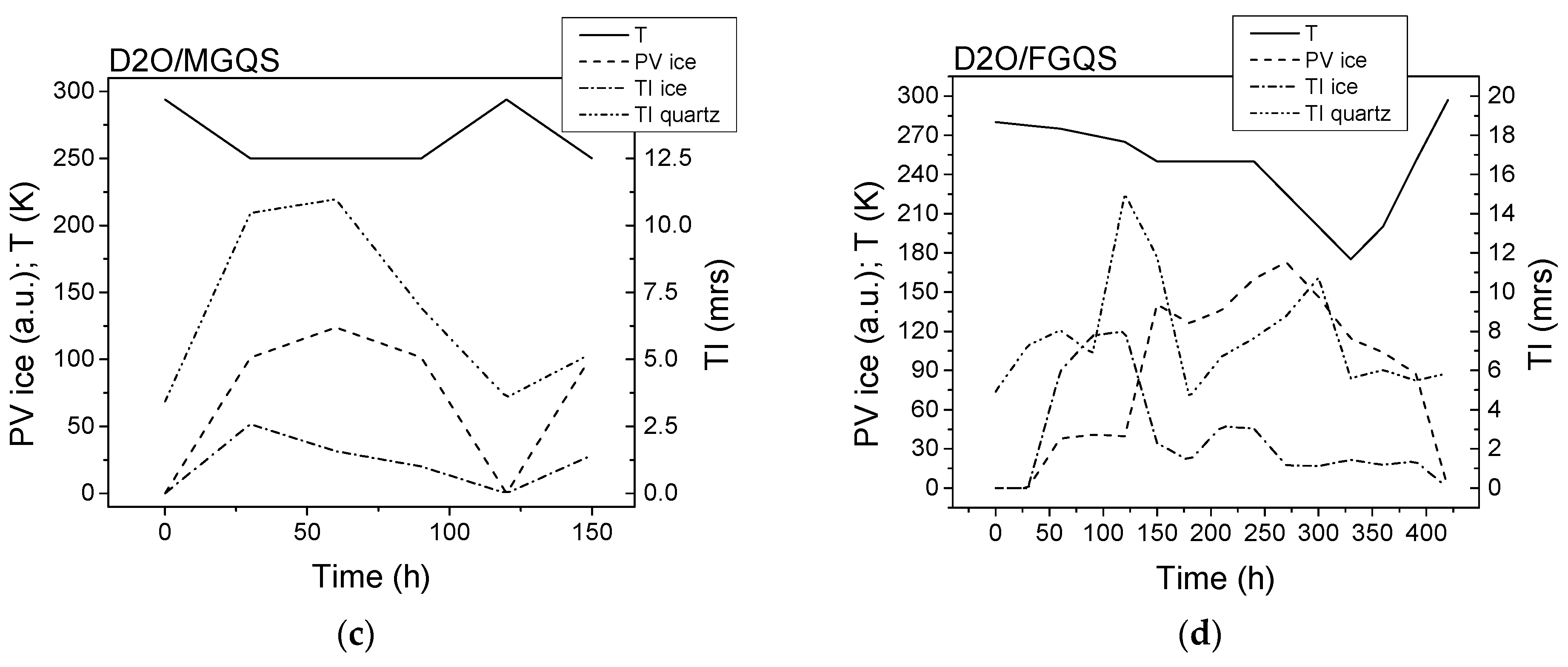
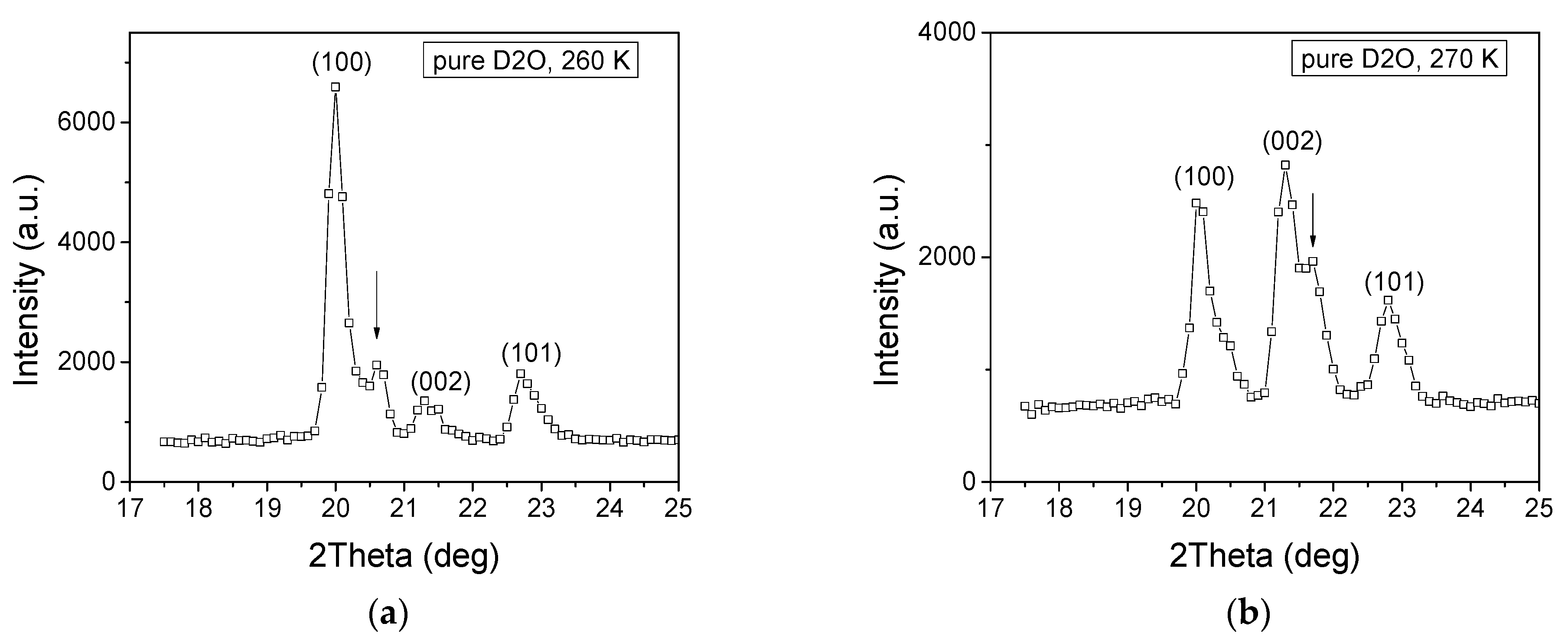
| Sample | Line (hkl) | Ahkl (a.u.) | cE (Å) | aE (Å) | σhkl (MPa) | σeff (MPa) |
|---|---|---|---|---|---|---|
| CGQS | 002 | 9061 | 7.362 | - | −1.2 | 56.12 |
| 5614 | 7.566 | - | 242.62 | |||
| 3468 | 7.282 | - | −96.81 | |||
| MGQS | 002 | 5824 | 7.323 | - | −47.81 | −54.48 |
| 3098 | 7.367 | - | 4.78 | |||
| 2763 | 7.252 | - | −132.66 | |||
| FGQS | 002 | 1949 | 7.370 | - | 8.37 | −1.12 |
| 1480 | 7.394 | - | 37.05 | |||
| 836 | 7.287 | - | −90.83 | |||
| Pure D2O | 100 | 11,924 | - | 4.517 | −9.73 | −55.08 |
| 4442 | - | 4.431 | −177.09 | |||
| 002 | 15,263 | 7.366 | - | 3.59 | −61.91 | |
| 10,166 | 7.229 | - | −160.15 |
Publisher’s Note: MDPI stays neutral with regard to jurisdictional claims in published maps and institutional affiliations. |
© 2021 by the authors. Licensee MDPI, Basel, Switzerland. This article is an open access article distributed under the terms and conditions of the Creative Commons Attribution (CC BY) license (https://creativecommons.org/licenses/by/4.0/).
Share and Cite
Kalvoda, L.; Dráb, M.; Kučeráková, M.; Vratislav, S. Freezing and Thawing of D2O/Sand Mixtures Investigated by Neutron Diffraction. Crystals 2021, 11, 961. https://doi.org/10.3390/cryst11080961
Kalvoda L, Dráb M, Kučeráková M, Vratislav S. Freezing and Thawing of D2O/Sand Mixtures Investigated by Neutron Diffraction. Crystals. 2021; 11(8):961. https://doi.org/10.3390/cryst11080961
Chicago/Turabian StyleKalvoda, Ladislav, Martin Dráb, Monika Kučeráková, and Stanislav Vratislav. 2021. "Freezing and Thawing of D2O/Sand Mixtures Investigated by Neutron Diffraction" Crystals 11, no. 8: 961. https://doi.org/10.3390/cryst11080961
APA StyleKalvoda, L., Dráb, M., Kučeráková, M., & Vratislav, S. (2021). Freezing and Thawing of D2O/Sand Mixtures Investigated by Neutron Diffraction. Crystals, 11(8), 961. https://doi.org/10.3390/cryst11080961






